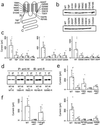The vitelliform macular dystrophy protein defines a new family of chloride channels
- PMID: 11904445
- PMCID: PMC122639
- DOI: 10.1073/pnas.052692999
The vitelliform macular dystrophy protein defines a new family of chloride channels
Abstract
Vitelliform macular dystrophy (VMD/Best disease; MIM*153700) is an early-onset autosomal dominant disorder in which accumulation of lipofuscin-like material within and beneath the retinal pigment epithelium is associated with a progressive loss of central vision. Bestrophin, the protein product of the VMD gene, has four predicted transmembrane domains. There are multiple bestrophin homologues in the human, Drosophila, and Caenorhabditis elegans genomes, but no function has previously been ascribed to these proteins, and they show no detectable homology to other proteins of known function. Using heterologous expression, we show here that human, Drosophila, and C. elegans bestrophins form oligomeric chloride channels, and that human bestrophin is sensitive to intracellular calcium. Each of 15 missense mutations asscociated with VMD greatly reduces or abolishes the membrane current. Four of these mutant bestrophins were coexpressed with the wild type and each dominantly inhibited the wild-type membrane current, consistent with the dominant nature of the disease. These experiments establish the existence of a new chloride channel family and VMD as a channelopathy.
Figures







Similar articles
-
The anion-selective pore of the bestrophins, a family of chloride channels associated with retinal degeneration.J Neurosci. 2006 May 17;26(20):5411-9. doi: 10.1523/JNEUROSCI.5500-05.2006. J Neurosci. 2006. PMID: 16707793 Free PMC article.
-
Molecular physiology of bestrophins: multifunctional membrane proteins linked to best disease and other retinopathies.Physiol Rev. 2008 Apr;88(2):639-72. doi: 10.1152/physrev.00022.2007. Physiol Rev. 2008. PMID: 18391176 Review.
-
Disease-causing mutations associated with four bestrophinopathies exhibit disparate effects on the localization, but not the oligomerization, of Bestrophin-1.Exp Eye Res. 2014 Apr;121:74-85. doi: 10.1016/j.exer.2014.02.006. Epub 2014 Feb 19. Exp Eye Res. 2014. PMID: 24560797 Free PMC article.
-
The mutation spectrum of the bestrophin protein--functional implications.Hum Genet. 1999 May;104(5):383-9. doi: 10.1007/s004390050972. Hum Genet. 1999. PMID: 10394929
-
Bestrophins and retinopathies.Pflugers Arch. 2010 Jul;460(2):559-69. doi: 10.1007/s00424-010-0821-5. Epub 2010 Mar 28. Pflugers Arch. 2010. PMID: 20349192 Free PMC article. Review.
Cited by
-
Role of bestrophin-1 in store-operated calcium entry in retinal pigment epithelium.Pflugers Arch. 2013 Apr;465(4):481-95. doi: 10.1007/s00424-012-1181-0. Epub 2012 Dec 4. Pflugers Arch. 2013. PMID: 23207577
-
Bestrophin 1 is indispensable for volume regulation in human retinal pigment epithelium cells.Proc Natl Acad Sci U S A. 2015 May 19;112(20):E2630-9. doi: 10.1073/pnas.1418840112. Epub 2015 May 4. Proc Natl Acad Sci U S A. 2015. PMID: 25941382 Free PMC article.
-
A novel variant of autosomal recessive best vitelliform macular dystrophy and management of early-onset complications.Saudi J Ophthalmol. 2022 Feb 18;35(2):159-163. doi: 10.4103/1319-4534.337863. eCollection 2021 Apr-Jun. Saudi J Ophthalmol. 2022. PMID: 35391813 Free PMC article.
-
Regulation of basolateral Cl(-) channels in airway epithelial cells: the role of nitric oxide.J Membr Biol. 2006;213(3):165-74. doi: 10.1007/s00232-006-0062-x. Epub 2007 Apr 28. J Membr Biol. 2006. PMID: 17468957
-
[Function of bestrophin].Ophthalmologe. 2005 Feb;102(2):122-6. doi: 10.1007/s00347-004-1157-3. Ophthalmologe. 2005. PMID: 15627200 Review. German.
References
-
- Berger J W, Fine S L, Maguire M G. Age-Related Macular Degeneration. St. Louis: Mosby; 1999.
-
- Stone E M, Sheffield V C, Hageman G S. Hum Mol Genet. 2001;10:2285–2292. - PubMed
-
- Weingeist T A, Kobrin J L, Watzke R C. Arch Ophthalmol. 1982;100:1108–1114. - PubMed
-
- Frangieh G T, Green W R, Fine S L. Arch Ophthalmol. 1982;100:1115–1121. - PubMed
-
- Marquardt A, Stohr H, Passmore L A, Kramer F, Rivera A, Weber B H. Hum Mol Genet. 1998;7:1517–1525. - PubMed
Publication types
MeSH terms
Substances
Grants and funding
LinkOut - more resources
Full Text Sources
Other Literature Sources
Medical
Molecular Biology Databases

